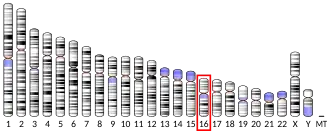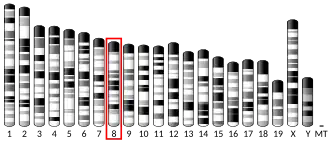Y+L amino acid transporter 2, also known as cationic amino acid transporter, y+ system, is a protein that in humans is encoded by the SLC7A6 gene.[5][6]
See also
References
Further reading
- Sekine Y, Nishibori Y, Akimoto Y, Kudo A, Ito N, Fukuhara D, Kurayama R, Higashihara E, Babu E, Kanai Y, Asanuma K, Nagata M, Majumdar A, Tryggvason K, Yan K (July 2009). "Amino acid transporter LAT3 is required for podocyte development and function". Journal of the American Society of Nephrology. 20 (7): 1586–96. doi:10.1681/ASN.2008070809. PMC 2709689. PMID 19443642.
- Suzuki Y, Yamashita R, Shirota M, Sakakibara Y, Chiba J, Mizushima-Sugano J, Nakai K, Sugano S (September 2004). "Sequence comparison of human and mouse genes reveals a homologous block structure in the promoter regions". Genome Research. 14 (9): 1711–8. doi:10.1101/gr.2435604. PMC 515316. PMID 15342556.
- Torrents D, Estévez R, Pineda M, Fernández E, Lloberas J, Shi YB, Zorzano A, Palacín M (December 1998). "Identification and characterization of a membrane protein (y+L amino acid transporter-1) that associates with 4F2hc to encode the amino acid transport activity y+L. A candidate gene for lysinuric protein intolerance". The Journal of Biological Chemistry. 273 (49): 32437–45. doi:10.1074/jbc.273.49.32437. hdl:2445/176951. PMID 9829974.
- Bröer A, Wagner CA, Lang F, Bröer S (August 2000). "The heterodimeric amino acid transporter 4F2hc/y+LAT2 mediates arginine efflux in exchange with glutamine". The Biochemical Journal. 349 Pt 3 (Pt 3): 787–95. doi:10.1042/bj3490787. PMC 1221206. PMID 10903140.
- Xu D, Hemler ME (August 2005). "Metabolic activation-related CD147-CD98 complex". Molecular & Cellular Proteomics. 4 (8): 1061–71. doi:10.1074/mcp.M400207-MCP200. PMC 1351277. PMID 15901826.
|
|---|
By group |
|---|
SLC1–10 |
|---|
| (1): | |
|---|
| (2): | |
|---|
| (3): | |
|---|
| (4): | |
|---|
| (5): | |
|---|
| (6): | |
|---|
| (7): | |
|---|
| (8): | |
|---|
| (9): | |
|---|
| (10): | |
|---|
|
| SLC11–20 |
|---|
| (11): |
- proton coupled metal ion transporter
|
|---|
| (12): | |
|---|
| (13): |
- human Na+-sulfate/carboxylate cotransporter
|
|---|
| (14): | |
|---|
| (15): |
- proton oligopeptide cotransporter
|
|---|
| (16): |
- monocarboxylate transporter
|
|---|
| (17): | |
|---|
| (18): | |
|---|
| (19): | |
|---|
| (20): | |
|---|
|
| SLC21–30 |
|---|
| (21): | |
|---|
| (22): | |
|---|
| (23): |
- Na+-dependent ascorbic acid transporter
|
|---|
| (24): | |
|---|
| (25): | |
|---|
| (26): |
- multifunctional anion exchanger
|
|---|
| (27): | |
|---|
| (28): |
- Na+-coupled nucleoside transport (SLC28A1
|
|---|
| (29): |
- facilitative nucleoside transporter
|
|---|
| (30): | |
|---|
|
| SLC31–40 |
|---|
| (31): | |
|---|
| (32): | |
|---|
| (33): | |
|---|
| (34): |
- type II Na+-phosphate cotransporter
|
|---|
| (35): |
- nucleoside-sugar transporter
-
-
-
-
- SLC35E1
- SLC35E2
- SLC35E3
- SLC35E4
|
|---|
| (36): | |
|---|
| (37): |
- sugar-phosphate/phosphate exchanger
|
|---|
| (38): |
- System A & N, sodium-coupled neutral amino-acid transporter
|
|---|
| (39): | |
|---|
| (40): |
- basolateral iron transporter
|
|---|
|
| SLC41–48 |
|---|
| (41): | |
|---|
| (42): | |
|---|
| (43): |
- Na+-independent, system-L like amino-acid transporter
|
|---|
| (44): | |
|---|
| (45): |
- Putative sugar transporter
|
|---|
| (46): | |
|---|
| (47): | |
|---|
| (48): | |
|---|
|
| |
|
|
|
see also solute carrier disorders |



